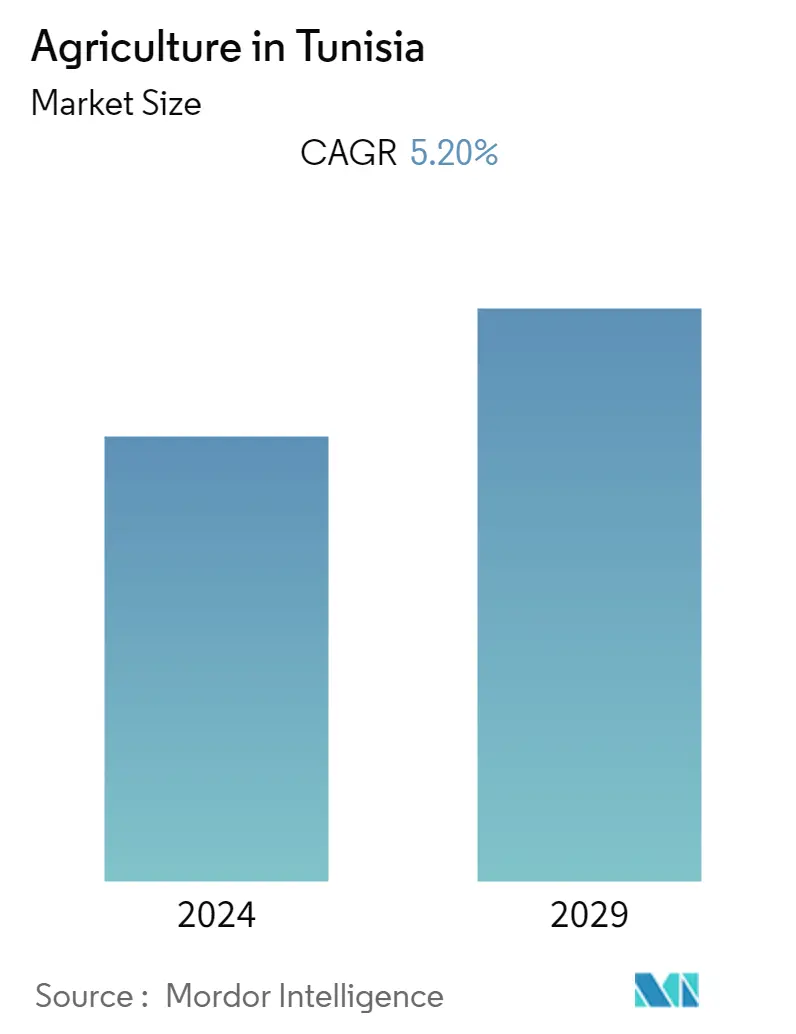Market Size of Agriculture in Tunisia

| Study Period | 2018 - 2029 |
| Base Year For Estimation | 2023 |
| Forecast Data Period | 2024 - 2029 |
| Historical Data Period | 2018 - 2022 |
| CAGR | 5.20 % |
Major Players*Disclaimer: Major Players sorted in no particular order |
Tunisian Agriculture Market Analysis
The Tunisia Agriculture Market is projected to grow at a CAGR of 5.2% during the forecast period.
- Agriculture is one of the key economic sectors in Tunisia, contributing to the domestic food security of the nation and providing employment to around 17% of the workforce. According to the World Bank, in 2021, the agriculture sector accounted for 9.14% of the country's GDP. Olives, wheat, barley, tomatoes, almonds, dates, broad beans, and apples are some of the important crops cultivated in the country. Olive oil is the most important agricultural product for Tunisia due to its high export value, as the country is the fourth largest olive producer in the world.
- Due to the country's proximity to European nations, most of the agricultural exports are targeted toward and are dependent on the European market. As a result, due to the growing demand for organic products in the European region and domestic market, organic farming in the country has increased in recent years to leverage the demand for organic products.
- Tunisia is a net importer of agricultural products due to the low domestic production of cereals and vegetables. The government of Tunisia and several global organizations have taken many measures to boost agricultural production in the country to meet the nation's food security and diversify the country's economy. For instance, the German Federal Ministry for Economic Cooperation and Development commissioned a project Promotion of Agricultural Economic Development in Tunisia (PEAD) in 2020, aimed at improving the agricultural productivity of smallholders in the country. The project also aims at developing small and medium agricultural enterprises, thereby improving the agricultural economy in the country.
Tunisian Agriculture Industry Segmentation
Agriculture is the practice of cultivating plants and crops such as cereals, fruits, vegetables, flowers, pulses, etc., for both human and animal consumption and other uses. The Agriculture Market in Tunisia is Segmented by Type into Food Crops/Cereal, Fruits, Vegetables, and Oilseeds/Non-food Crops. The report also offers Production Analysis, Consumption Analysis (Volume and Value), Import Analysis (Volume and Value), Export Analysis (Volume and Value), and Price Trend Analysis in the country. The report offers market size and forecast in terms of value in USD million and volume in metric ton for the above-mentioned segments.
| Crop type | |||||||
| |||||||
| |||||||
| |||||||
|
Agriculture in Tunisia Size Summary
The agriculture sector in Tunisia plays a crucial role in the country's economy, contributing significantly to food security and employment. It is a vital part of the national GDP, with key crops including olives, wheat, barley, tomatoes, almonds, dates, broad beans, and apples. Olive oil stands out as the most significant agricultural product due to its high export value, positioning Tunisia as a leading global olive producer. The country's agricultural exports are primarily directed towards European markets, benefiting from the proximity and demand for organic products. This has led to a rise in organic farming, supported by government policies aimed at increasing organic cultivation to meet both domestic and international demand.
Despite being a net importer of agricultural products, Tunisia exports a variety of agricultural goods, such as tomatoes, olive oil, and dates, bolstered by trade agreements with European Union nations. Initiatives like the PAMPAT 2 project further promote Tunisian agricultural products globally, enhancing export value. The government, along with international organizations, has been active in boosting agricultural productivity through projects aimed at supporting smallholders and developing agricultural enterprises. These efforts, combined with the increasing area under organic cultivation and global demand for organic exports, are expected to drive growth in Tunisia's agriculture market over the forecast period.
Agriculture in Tunisia Market Size - Table of Contents
-
1. MARKET DYNAMICS
-
1.1 Market Overview
-
1.2 Market Drivers
-
1.3 Market Restraints
-
-
2. MARKET SEGMENTATION
-
2.1 Crop type
-
2.1.1 Food Crops/Cereals
-
2.1.1.1 Production Analysis
-
2.1.1.2 Consumption Analysis (Volume and Value)
-
2.1.1.3 Import Market Analysis (Volume and Value)
-
2.1.1.4 Export Market Analysis (Volume and Value)
-
2.1.1.5 Price Trend Analysis
-
-
2.1.2 Fruits
-
2.1.2.1 Production Analysis
-
2.1.2.2 Consumption Analysis (Volume and Value)
-
2.1.2.3 Import Market Analysis (Volume and Value)
-
2.1.2.4 Export Market Analysis (Volume and Value)
-
2.1.2.5 Price Trend Analysis
-
-
2.1.3 Vegetables
-
2.1.3.1 Production Analysis
-
2.1.3.2 Consumption Analysis (Volume and Value)
-
2.1.3.3 Import Market Analysis (Volume and Value)
-
2.1.3.4 Export Market Analysis (Volume and Value)
-
2.1.3.5 Price Trend Analysis
-
-
2.1.4 Oilseeds/Non-food crops
-
2.1.4.1 Production Analysis
-
2.1.4.2 Consumption Analysis (Volume and Value)
-
2.1.4.3 Import Market Analysis (Volume and Value)
-
2.1.4.4 Export Market Analysis (Volume and Value)
-
2.1.4.5 Price Trend Analysis
-
-
-
Agriculture in Tunisia Market Size FAQs
What is the current Agriculture in Tunisia Market size?
The Agriculture in Tunisia Market is projected to register a CAGR of 5.20% during the forecast period (2024-2029)
What years does this Agriculture in Tunisia Market cover?
The report covers the Agriculture in Tunisia Market historical market size for years: 2018, 2019, 2020, 2021, 2022 and 2023. The report also forecasts the Agriculture in Tunisia Market size for years: 2024, 2025, 2026, 2027, 2028 and 2029.

